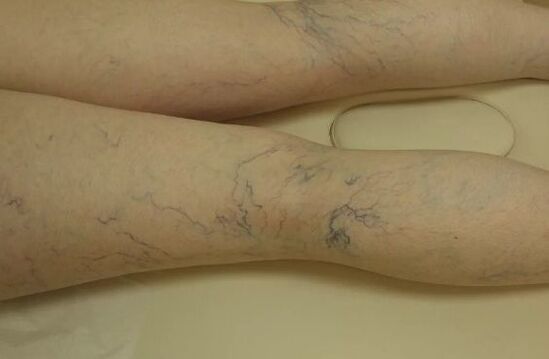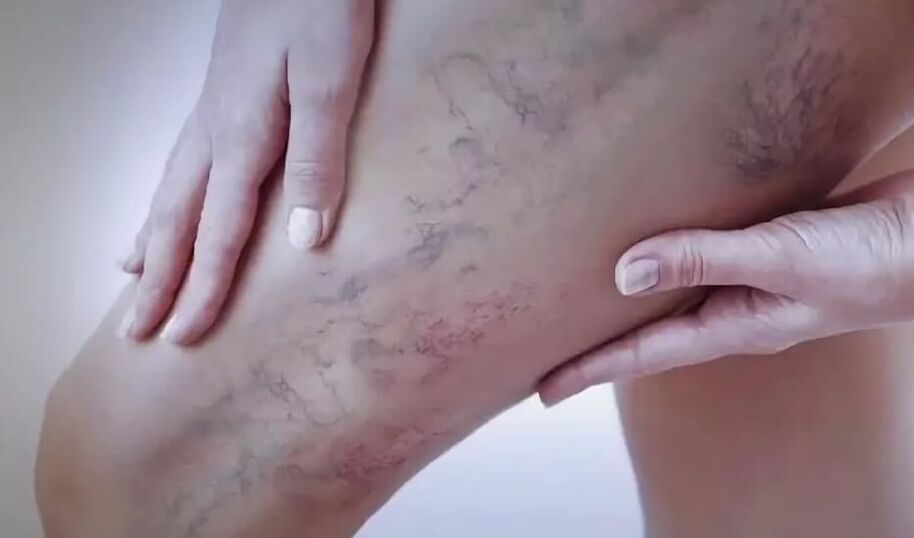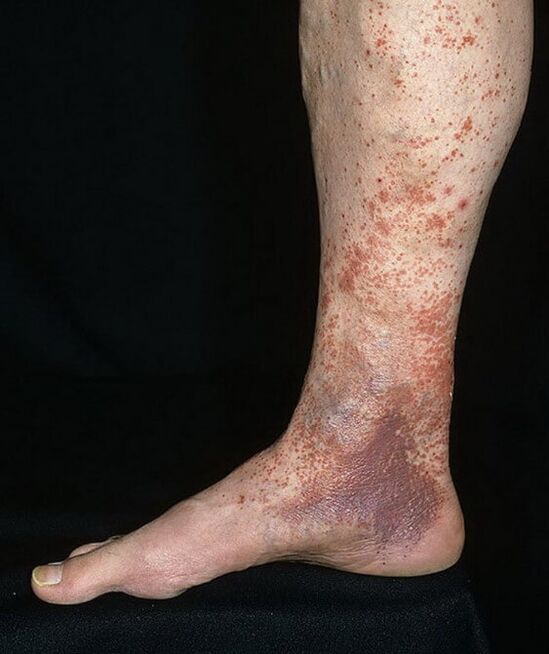Varicose veins in the legs are a chronic change in blood flow, as a result of the impact of the mechanical, toxic, traumatic or other factor.
To better understand the essence of the pathological process, you need to refer to anatomical information.
The lower limbs are supplied in two main ways:
- In the arterial branches.They carry oxygen -rich blood, which simply provides cells with useful compounds.
- Through veins.Liquid tissue tolerate carbon dioxide and unnecessary substances for processing, in the opposite movement of blood by structures, veins are involved.
It should be noted that different types of blood vessels are not connected or reported, the systems are completely closed.
Blood through the veins move strictly in one direction.The muscle layer in these structures is quite poor, all the work falls into the special valves.They are like partitions, doors that do not pass the liquid tissue in the opposite direction from applications.
In contrast to the background of increased venous pressure, damage, damage and other factors, the valves weaken.Blood moves back, the load on the walls of the blood vessel increases.Vienna wears many times faster.
Under mechanical effect, call structures change their properties and sizes.Varicosis itself begins.
This disease is characterized by vascular deformities, a decrease in their functional activity, extensions similar to the aneurysm of the walls along the entire length.
Varicosis is dangerous in that over time leads to a disruption of the vein, the formation of blood clots, the death of local fabrics.Treatment should begin immediately, from the moment the pathological process is detected.
A characteristic feature of a disorder is a relatively vague progress.The main contingent of patients is men and women over 18 years of age.
Despite relatively unclear development, the disease behaves unpredictably.Never say in advance what point critical complications will take place.
A doctor who treats the disease is a fetologist.
Development mechanism
The pathological process is based on heterogeneous factors, if they are generalized and consist of a rough appearance, the options will be as follows:
Mechanical influence
Increased physical activity in the veins of the legs.Found, for example, with intense sports.The most common options are the features of professional activity (builders, teachers, chefs and others suffer), increased body weight, as the foot load increases.
There is every chance to overcome the pathological process in time.The main thing is to eliminate the abnormal factor.
Traumatic lesions of the surrounding tissue
Not the veins themselves, but the surrounding areas.Bruises of soft structures, muscles, ligaments, partial and complete fractures.
There are two reasons for the development of varicose veins: compression of blood vessels with altered tissues, and also uneven redistribution of load on the lower extremities.
Interestingly, varicose vein culprits can also be diseases of the muscular -Skeletal system: arthritis and the like.
Foot -compression
This refers to external influence.Violation of blood flow often provokes patients with their unreasonable actions.
For example, coating of tights or tight socks is affected.Particularly similar are women who are willing to get into the pursuit of beauty.
When compressing the feet of the region, which lie under the compression site, they undergo stale processes.The venous-lymphatic outflow is significantly concerned.This leads to varicose veins at progressive speed.
There are times when the pathological process began later, years later from the negative impact.
Violations of hormonal balance
Disordishes the production of the production of the thyroid gland, the adrenal glands and the pituitary gland are affected.
Change may affect other compounds: Reproductive system hormones, androgens, estrogens.They partially regulate the tone of large vessels, veins and arteries.
Genetic characteristics
Infusion history, according to research, plays almost the main role in developing the pathological process.This is not a trigger, but a clear premise that increases probability several times.
Of course, the presence of a relative suffering from varicose veins is not a guarantee of the development of the pathological process, but the probability is significantly higher.
It is necessary to adhere to the prevention rules in order to minimize the risks.
Hypovitaminosis
For normal work, regeneration of veins, arteries, ascorbic acid is needed.Also, Group B vitamins, E, D. There can be no normal restoration of blood vessels without them.They get tired quickly, lose their former elasticity.
If the absence state lasts long, from a few months, to avoid changes from the veins.
The disease develops faster than usual, progression at a pronounced phase, dangerous lasts only a few months, a maximum of several years.
Congenital shipping abnormalities
The images, as a rule, do not develop in isolation.Other deviations can be found.Therefore, diagnosis is not of problems.
Natural state
Pregnancy, severe birth, hormonal background features in adolescence or closer to old age.
There are other mechanisms that are less common.For example, intoxication, exposure to the body of radiation and others.Are named the most common.
Varicose veins is a disease characterized by a deviation system: vein deformities, aneurysm formation, stars, thinning of the inner lining.The impact of a group of pathogenetic factors is possible.
ClaSSIFICaTION
The unit methods relate to the stage of the pathological process, its form.About everything okay.
The technique adopted in medicine distinguishes three degrees of development of the disease:
- Offset.Symptoms as such are missing, the patient makes no complaints of health.The pathological process at the beginning of its development.But there are already obvious signs: diluted veins adhere through the thickness of the skin.For several years, the violation will go to a new phase.
- Subcompensation.The clinical signs of varicose vessels are clearly expressed.Among them, you can distinguish pain, severity in the legs, a feeling of running, weakness, convulsions at night.After the break, they come to nothing.Apparent manifestations are also present.You can make a diagnosis without problems.
- dismounting.In addition to the already mentioned symptoms, additional: numbness of the feet, loss of sensitivity, common skin rash, constant itching and burnt areas of the lesion.
There are true risks of tissue necrosis, thrombosis.Treatment is urgent, otherwise - not to go through disability.
ABLE

There is a generally accepted international typology of the pathological process in stages (class):
- 0. The obvious symptoms of disorders are minimal.Patients talk about severity in the lower extremities.This phase can last indefinitely.
- 1. The stars form on the surface of the legs, the veins are expanding and becoming clearly visible.The clinic is the same yet.Maximum - episodes of nightly seizures develop, which interrupt so quickly and suddenly when they began.
- 2. The clinical signs are identical.With a visual assessment of the lower extremities, the doctor detects visible varicose changes from the veins: they branch, extend, form complex deformities.
- 3 From this stage, the edema pronounced begins.
- 4. Redness appears, itchy varicose dermatitis.The skin on the surface of the lesion changes the shade to the dark, significantly compacts and dries.It becomes thin because any mechanical effect provokes painful, deep combing.
- 5. Small erosions appear.
- 6. Full trophic ulcers are developing.
For complete formation of the pathological process, from 0 to stage 6, it requires up to several decades.
Symptoms
Clinical photography depends on the phase of the disorder.If you submit an average list of manifestations, the list will be as follows:
- Height.Especially, after a mechanical load, a long -term working day.Walking, staying in a place becomes problematic.Over time, the symptom only intensifies, which indicates the progression of the violation, and allows you to doubt varicose veins at very early stage.
- Intolerance to physical activity.At first the patient is unable to walk for a long time, then stay.If you start a disorder, it will only deteriorate.A person will not be able to climb the stairs without long vacation, vacation.This is due to venous lymph stagnation in enlarged veins.
- Pain of different intensities.In the initial phase they are missing.Then, after a few months or years, the severity of the manifestation is increasing.Start unpleasant, unpleasant sensations.
They intensify after physical activity, with a sharp change in body position.
 Until the last stages of the disease, the symptom remains constantly with the patient, does not leave at all.
Until the last stages of the disease, the symptom remains constantly with the patient, does not leave at all. - Visual changes from ships.They look like abnormal branching, the formation of standing stars.These manifestations clearly show the onset of varicose vessels.Therefore, diagnosis over time is becoming easier.It remains only to clarify the localization of the changes and their rank.
- Swelling.They start gradually, approximately with the second or third phase of the pathological process.First - by the end of the day.Spend after a night break.Then, changes in volume are stored constantly, they do not end at all.As a rule, the signs are connected first, then the next leg.
- Cramps in the dark.Violation of muscle tone, cramping, is one of the first signs of varicose veins, which is due to the slowdown in the venous lymph appearance, tissue trochphs and cellular respiration.
Standing crampsThey prevail at night, accompanied by very severe pain.The patient cannot stay on the affected leg during the day, or even some.Gradually, the frequency of spasms becomes only higher.
- Itching.An alarm sign of varicose veins, which characterizes gradual dystrophic disorders.In the initial phase of erosion, there are still no ulcers.But this is a matter of time.
- The change of dermis shade.Hyperpigmentation.Darkness of the surface of the skin.Closer to the final stage of the pathological process, the lower leg acquires a raspberry rich coloring.
A characteristic symptom of varicose veins of the lower extremities is the skin seal on the lesion, which is associated with gross tissue tooth under the surface of the epidermis, the outer layer of the skin.
- Forming a rash.SO -Called varicose dermatitis.This is a vanguard of the final stage of the pathological process.Small papules are very Christian, they do not allow the patient to live normally.Complications are possible, secondary infection of wound surfaces.
- Trophic ulcers.A clinical sign, which is characterized by the formation of large erosion, focuses of tissue decay.First - surface, then fat fiber.And there is no far from necrosis.Therefore, you cannot withdraw with treatment.

Symptoms of varicose veins are caused by trophic tissue trophies, venous-lymphatic outlet disorders, epidermis destruction and subcutaneous fat.
Clinical signs progress slowly because there is every chance to start timely treatment.Patient's task is not to lose an important point.
Profile specialists to contact - a phlebologist, dermatologist, hematologist.
Reason
Varicosis develops as a result of a combination of factors or influence of one but a very intense provocateur.
There are several options:
- Physical activity.Long walking, staying calm.Usually, such a moment is associated with the features of professional activity, lifestyle.
- Injuries.Fractures, full or partial.Also bruising, soft tissue damage.
- Hypovitaminosis.Lack of group B, E, D, ascorbic acid.
- Genetic factors.Heritage moments, the busy family story.The possibility of a pathological process increases, but there is no guarantee that the disease will begin.
- Myoses in the background of hypothermia, physical overload.
- Arthritis.Joint inflammation.
- Hormonal inequality.Lack or excess joints of the thyroid gland, adrenal glands, pituitary gland.
- Flebit of the foot vessels.The cause of varicose veins in inflammation of the veins of an infectious or non -infectious nature.
- Vasculitis of the lower extremities vessels.Autoimmune lesions.
- Pregnancy.Since the hormonal background changes and the load on the foot, the entire musculoskeletal system increases.
- Perthetic periods.Up to about 17-20 years.
- Menopausa (andropause).Climate.Gradual weakening of reproductive function.
The causes of varicose veins can be traumatic, inflammatory, degenerative, dystrophic.
Troubleshooting
Flebologists are engaged in examination.Only then, if necessary, the other specialists are connected.Among the methods:
- Oral survey.The doctor should understand what the patient himself complains.
- The dependent collection.Studying the potential origin of the problem.
- Visual evaluation of the condition of the feet.On the basis, there is an opportunity to study the nature of the pathological process, its features.
- Palpation.Physical technique.
- Uzdg.Dopplerography of foot vessels.It allows you to detect anatomical changes from the lower extremities, deviations of the blood flow velocity.Used as the main methodology.This makes it possible to quickly make a diagnosis and study the degree of disorder.
- X -Ray.If there is such a need.
- In particularly difficult cases, the doctor prescribes an MRI.
The development of varicose veins in the leg is a sufficient, visual sign characteristic of the expansion of the veins of the lower extremities, can be diagnosed in it.Next, it remains to determine the severity of the pathology.
Treatment
The therapy in the initial stages is conservative.In total, three approaches to correction can be distinguished.
potion.It includes a systematic administration of medicines.Tools are prescribed that stimulate microcirculation, blood flow, valves, protect vessels from further destruction of tissue.
Among the funds of funds:
- Venotonics.
- Angioprotectors.
- Vitamins, antioxidants.
Moreover, physiotherapy, exercise therapy, massage is actively described, the coating of compression knitwear is indicated.
A conservative technique is used in the initial stages of the disease or for auxiliary correction in the other method.
A minimal invading approach.Treatment of varicose veins of the lower extremities involves the destruction of affected vessels using a special sclerosis drug, liquid nitrogen.
Sclerotherapy methodology, or radio frequency ablation is used in pronounced but not critical stages of the disease.
Surgical approach.Treatment of varicose veins in the foot requires the use of laser, electric currents or direct removal of the affected vessels - phlebectomy.
The doctor removes half the structure, sews healthy areas, forming anastomosis.Very soon the blood flow is back.
There are several operating techniques.The choice remains with the doctor.
Predict
The varicose veins in the legs fully heal in the first three stages, then there are risks of complications, irreversible changes in foot tissue: ulcers, muscle atrophy and others.Although survival is still almost 100%.
Against the backdrop of necrosis, ordinary erosion, sepsis, probability of death increases ten times.
In general, the disease is treated well.
PREVENTION
Preventive measures are very simple, the main thing is to strictly adhere to them:
- Dividets.Every hour or two you have to press.Especially with a sedentary/standing lifestyle.
- Wearing comfortable shoes, socks, sweater.Preferably from natural materials.
- Use of compression knitwear clothing.
- Easy physical activity.Swimming, jogging.The main thing is not to overload.
- Proper food.More vitaminized products.
- The optimal way of drinking.1.5-2 liters per day.
Fluid deficiency adversely affects, blood thickens, moves worse through vessels, pressure increases in the venous network.
Consequences
Complications can be deadly.Among the options:
- Muscle dystrophy.
- Pareza.Partial loss of sensitivity
- Formation of ulcers with the probability of secondary infection.
- Necrosis of the clothes.Gangrene.Especially with the loss of deep veins.
- Foot Bombosis, thrombophlebitis.
- Sepsis.Blood poisoning.
- Disability.
The varicose veins of the lower extremities are a pathological change in the shape, structure, elasticity of the vessels (and not only) with the loss of muscle functions.
The disease develops slowly, but without quality treatment, the result will be deplorable.























